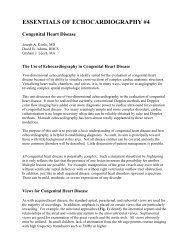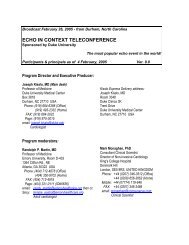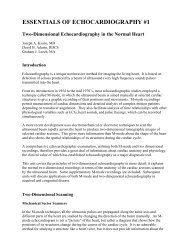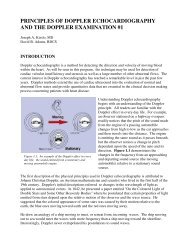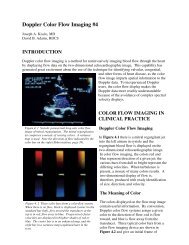doppler evaluation of valvular stenosis #3 - Echo in Context
doppler evaluation of valvular stenosis #3 - Echo in Context
doppler evaluation of valvular stenosis #3 - Echo in Context
Create successful ePaper yourself
Turn your PDF publications into a flip-book with our unique Google optimized e-Paper software.
DOPPLER EXAMINATIONS FOR VALVULAR STENOSIS<br />
As seen from the many examples described <strong>in</strong> this Unit, considerable operator skill is necessary to<br />
acquire the critical quantitative data necessary by Doppler for the assessment <strong>of</strong> <strong>valvular</strong> <strong>stenosis</strong>.<br />
Po<strong>in</strong>ts to keep <strong>in</strong> m<strong>in</strong>d when carry<strong>in</strong>g out an exam<strong>in</strong>ation <strong>in</strong>clude:<br />
H<strong>in</strong>t 1: An operator should never be satisfied by <strong>in</strong>terrogat<strong>in</strong>g an abnormal jet by only one view.<br />
Stenotic jets may move <strong>in</strong> any direction. This is particularly true <strong>of</strong> aortic <strong>stenosis</strong> and apical, right<br />
parasternal, and suprasternal approaches must be used before an operator can be assured that the<br />
highest peak jet possible has been recorded.<br />
H<strong>in</strong>t 2: Reliable quantitative assessments require that high quality spectral record<strong>in</strong>gs are available<br />
for analysis. Measurement <strong>of</strong> peak velocities from poorly formed Doppler pr<strong>of</strong>iles may lead to<br />
serious underestimations <strong>of</strong> trans<strong>valvular</strong> gradients. When it is impossible to acquire a fully<br />
formed pr<strong>of</strong>ile, it is best not to attempt quantitative assessment. Beg<strong>in</strong>ners are sometimes tempted<br />
to make some measurement with the expression that a gradient is “at least” a certa<strong>in</strong> amount. In<br />
our experience, this only leads to confusion <strong>in</strong> later decision-mak<strong>in</strong>g processes.<br />
H<strong>in</strong>t 3: Much <strong>of</strong> the utility <strong>of</strong> Doppler for the assessment <strong>of</strong> <strong>valvular</strong> <strong>stenosis</strong> is based on the use<br />
<strong>of</strong> CW methods. S<strong>in</strong>ce this is frequently performed with a stand-alone transducer, there is no<br />
image available for anatomic reference. An operator must use frequent voice annotations on the<br />
video record<strong>in</strong>g to assist <strong>in</strong> later <strong>in</strong>terpretation and reference. We recommend voice notation <strong>of</strong> the<br />
valve be<strong>in</strong>g <strong>in</strong>terrogated and the angulations be<strong>in</strong>g used as the beam is directed spatially. This<br />
frequently helps <strong>in</strong> elim<strong>in</strong>at<strong>in</strong>g confusion between the various abnormal flows that might be<br />
encountered dur<strong>in</strong>g a Doppler exam<strong>in</strong>ation.<br />
H<strong>in</strong>t 4: When <strong>in</strong>terpret<strong>in</strong>g Doppler <strong>in</strong>formation for assessment <strong>of</strong> the severity <strong>of</strong> <strong>valvular</strong> <strong>stenosis</strong><br />
all available <strong>in</strong>formation must be taken <strong>in</strong>to account to avoid excessive dependence on any one<br />
quantitative <strong>in</strong>dex. For example, a patient with severe aortic <strong>stenosis</strong>, a dilated left ventricle and<br />
low cardiac output may only have a 3 m/s aortic stenotic jet s<strong>in</strong>ce flow across the aortic valve is<br />
low. Without an estimate <strong>of</strong> aortic valve area, this would lead to the <strong>in</strong>correct assumption that<br />
m<strong>in</strong>imal aortic <strong>stenosis</strong> is present.



